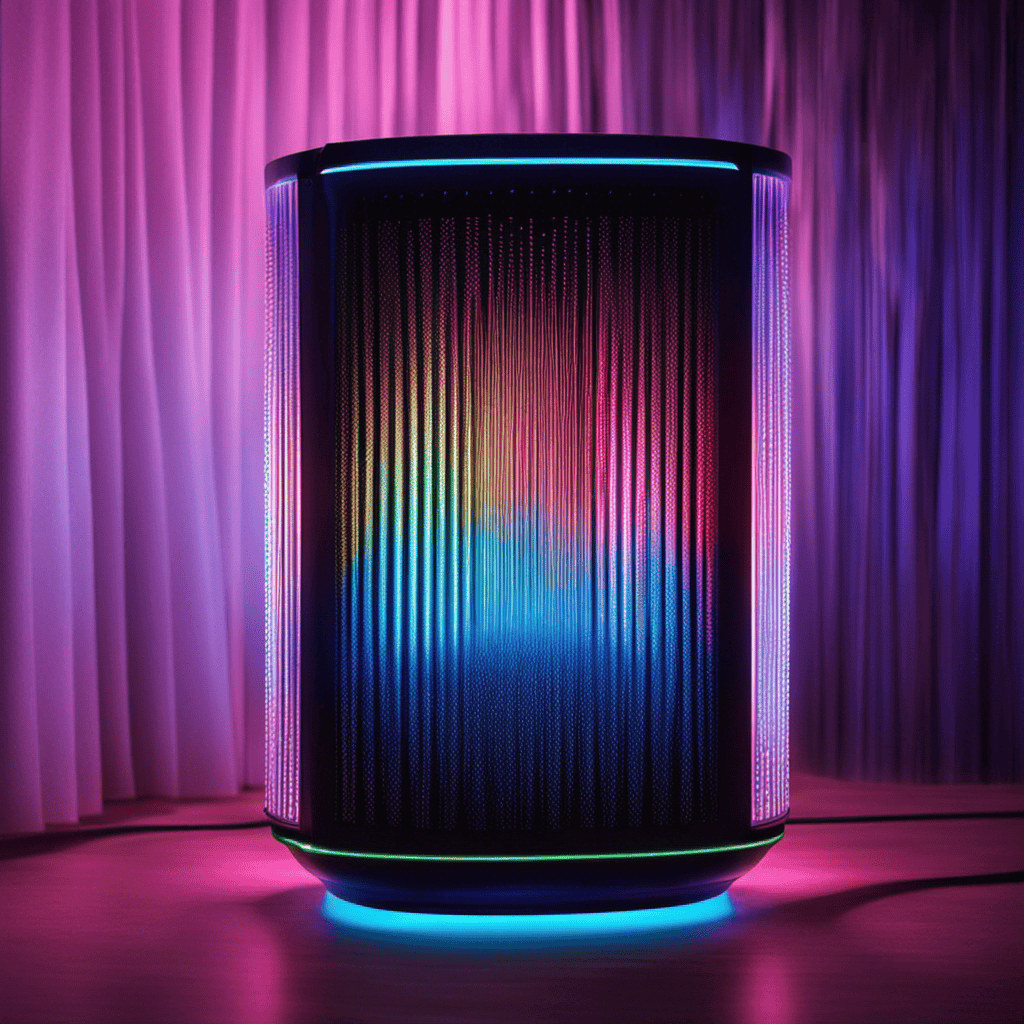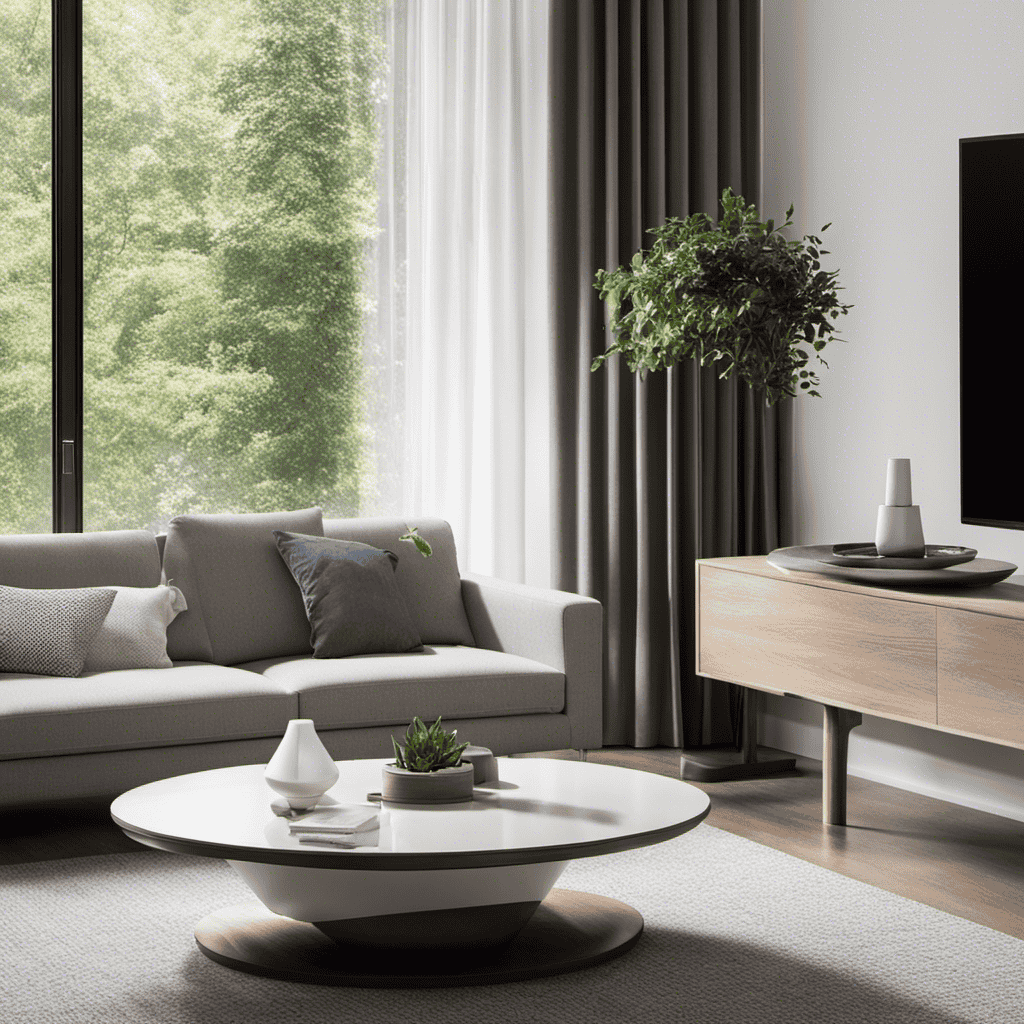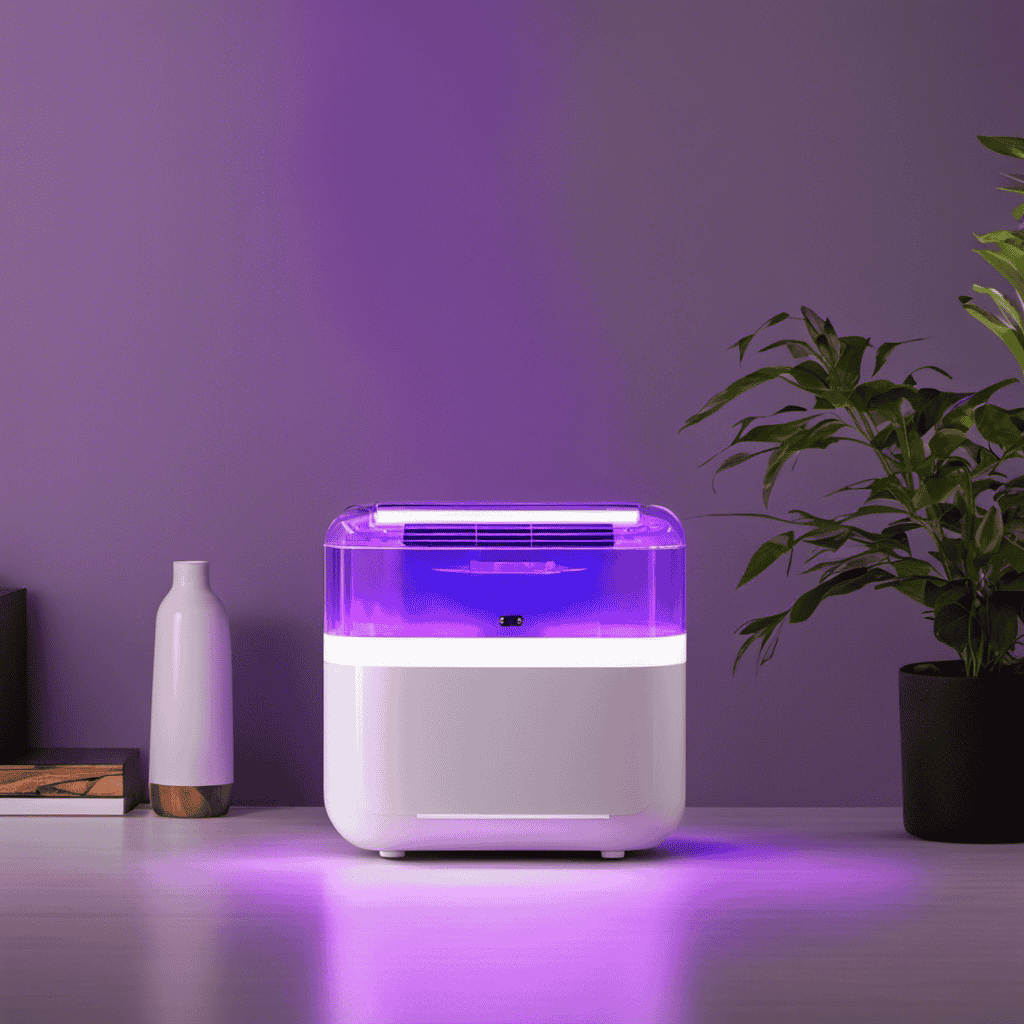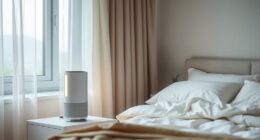I know what you’re wondering – is ozone in air purifiers actually safe? Allow me to explain it to you.
Ozone, a powerful oxidizing agent, is often used in air purifiers to eliminate odors and kill bacteria. However, its use comes with pros and cons.
In this article, we’ll explore the basics of ozone generation, its role in air purification, and its effects on indoor air quality. We’ll also dive into its effectiveness against VOCs, bacteria, and pet dander, as well as the regulations and standards surrounding ozone in air purifiers.
So, let’s get started and clear the air on ozone in air purifiers.
Key Takeaways
- Ozone is used in air purifiers to eliminate odors and kill bacteria.
- Ozone can react with pollutants and break them down to improve air quality.
- Ozone can irritate the respiratory system and worsen allergy symptoms.
- It is important to choose air purifiers with low ozone emissions and use them in well-ventilated areas.
The Basics of Ozone in Air Purifiers
Ozone is a gas that can be produced by air purifiers. This gas is known for its powerful ability to remove odors and kill bacteria. However, it is important to understand that ozone can also have negative effects, especially for people with allergies.
Ozone is produced through a process called ozone generation. This process involves using electrical energy to convert oxygen molecules (O2) into ozone (O3). When ozone is released into the air, it can react with pollutants and break them down. While this can be beneficial for improving air quality, ozone can also irritate the respiratory system and worsen allergy symptoms.
Therefore, it is crucial to have a good understanding of ozone generation and its potential impact before using an air purifier that produces ozone.
Understanding Ozone Generation
When discussing ozone in the context of air purifiers, it’s important to understand the potential health risks associated with its generation. Ozone can be harmful to human health, causing respiratory issues and exacerbating existing conditions like asthma.
Additionally, it’s crucial to differentiate between ozone and ionizers, as they’re two distinct air purification technologies with different effects on indoor air quality.
Lastly, it’s essential to be aware of ozone regulation laws, which vary across different regions and aim to protect individuals from excessive ozone exposure.
Ozone Health Risks
There’s a potential health risk associated with high levels of ozone emitted by air purifiers. Ozone exposure can have detrimental effects on lung function. When ozone is inhaled, it reacts with the lining of the respiratory system, causing irritation and inflammation. This can lead to symptoms such as coughing, wheezing, shortness of breath, and chest tightness.
Prolonged exposure to high levels of ozone can also worsen existing respiratory conditions like asthma and bronchitis. Studies have shown that ozone can decrease lung function and impair the ability of the lungs to take in oxygen. It is important to choose air purifiers that have low ozone emissions and to use them in well-ventilated areas.
In the next section, we will explore the differences between ozone and ionizers in air purifiers.
Ozone Vs. Ionizers
Using ionizers in well-ventilated areas is a safer alternative to air purifiers that emit high levels of ozone. While air purifiers with ozone-emitting capabilities may claim to effectively clean the air, they can also pose health risks due to the ozone they release. Ionizers, on the other hand, work by releasing negative ions into the air, which attach to and remove harmful particles such as dust, pollen, and pet dander. These devices are considered safe and effective for improving indoor air quality without the risk of ozone exposure.
To better understand the differences between ozone-emitting air purifiers and ionizers, let’s take a look at the following table:
| Aspect | Ozone-emitting Air Purifiers | Ionizers |
|---|---|---|
| Ozone Emission | High | None |
| Particle Removal | Effective | Effective |
As you can see, ionizers provide an effective solution for improving air quality without emitting ozone. This makes them a safer choice for individuals concerned about ozone safety.
Now that we understand the effectiveness of ionizers, let’s delve into the regulations surrounding ozone in air purifiers.
Ozone Regulation Laws
Ionizers are subject to regulations regarding the emission of ozone. Ozone exposure limits and ozone monitoring requirements are put in place to ensure the safety and well-being of users.
Ozone, a molecule made up of three oxygen atoms, can be harmful when present in high concentrations. Exposure to high levels of ozone can cause respiratory problems and worsen existing lung conditions.
To protect consumers, regulatory agencies have set limits on the amount of ozone that ionizers can emit. These limits vary depending on the country and jurisdiction.
In addition to ozone exposure limits, manufacturers are also required to monitor and report the ozone levels produced by their ionizers. This helps to ensure compliance with the regulations and provides transparency to consumers.
The Role of Ozone in Air Purification
You may be wondering about the role of ozone in air purification. Ozone is a powerful oxidant that can help eliminate pollutants in the air. Here are three important ways in which ozone contributes to air purification:
-
Ozone’s impact on indoor pollutants: Ozone has the ability to break down and remove various indoor pollutants, such as volatile organic compounds (VOCs), bacteria, and mold. It reacts with these pollutants and neutralizes their harmful effects, improving the overall air quality.
-
Ozone’s role in reducing airborne particles: Ozone can effectively reduce airborne particles by causing them to cluster together and settle out of the air. This process, known as agglomeration, helps remove dust, pollen, and other particles from the indoor environment.
-
Ozone’s ability to neutralize odors: Ozone has a strong odor-eliminating effect and can neutralize unpleasant smells caused by pets, cooking, or other sources. It breaks down the odor-causing molecules, eliminating the odors and leaving the air fresh and clean.
Understanding the role of ozone in air purification is crucial when considering the pros and cons of using ozone in air purifiers.
Pros and Cons of Ozone in Air Purifiers
When considering air purifiers, it’s important to weigh the pros and cons of incorporating ozone technology.
Ozone, a molecule made up of three oxygen atoms, can effectively eliminate harmful pollutants in the air. One of the major advantages of ozone in air purifiers is its ability to neutralize strong odors caused by smoke, pet dander, and cooking. It can also eliminate bacteria, viruses, and mold spores, providing a cleaner and healthier indoor environment.
However, it’s crucial to consider the potential drawbacks as well. Ozone can irritate the respiratory system and worsen allergies and asthma symptoms in some individuals. Prolonged exposure to high levels of ozone can even cause lung damage.
Therefore, it’s important to carefully consider the pros and cons before deciding to incorporate ozone technology in air purifiers.
Ozone’s Effect on Indoor Air Quality
When it comes to ozone and health risks, it is important to understand the potential dangers associated with exposure to high levels of ozone.
Ozone has been known to cause respiratory issues, such as coughing, chest tightness, and shortness of breath.
In comparison to other air pollutants, ozone is unique because it is not emitted directly into the air, but rather forms from chemical reactions between nitrogen oxides and volatile organic compounds in the presence of sunlight.
Lastly, while ozone can be effective in purifying the air by eliminating odors and killing bacteria and viruses, its effectiveness may vary depending on factors such as ozone concentration, exposure time, and the specific pollutants present.
Ozone and Health Risks
Ozone in air purifiers can pose health risks. While ozone is often used in air purifiers to eliminate odors and kill bacteria, excessive exposure to ozone can have detrimental effects on our health. It is important to be aware of the symptoms of ozone exposure and the potential long-term effects.
Here are three important points to consider regarding ozone and its impact on our health:
-
Ozone exposure can cause respiratory issues such as coughing, chest tightness, and shortness of breath. These symptoms can be particularly severe for individuals with pre-existing respiratory conditions such as asthma or chronic obstructive pulmonary disease (COPD).
-
Prolonged exposure to high levels of ozone can lead to lung damage and even permanent scarring of the lung tissue. This can result in decreased lung function and increased susceptibility to respiratory infections.
-
Ozone has also been linked to various other health issues, including eye irritation, headaches, and throat irritation.
It is crucial to carefully consider the use of ozone-generating air purifiers and prioritize the health and safety of individuals, especially those with respiratory conditions. If you experience any symptoms related to ozone exposure, it is important to seek medical attention and minimize further exposure.
Ozone Vs. Air Pollutants
The comparison between ozone and other air pollutants is crucial in understanding their respective impacts on our health. Ozone, a major component of smog, is known to have harmful effects on the respiratory system. However, when compared to other air pollutants such as particulate matter (PM) and nitrogen dioxide (NO2), ozone has different characteristics and risks.
To further understand these differences, let’s take a look at the table below:
| Air Pollutant | Health Risks | Ozone Reduction Techniques |
|---|---|---|
| Ozone | Respiratory issues, lung inflammation | Reduce emissions from vehicles and industrial sources, use air purifiers with ozone filters |
| Particulate Matter (PM) | Lung and heart problems, asthma exacerbation | Improve indoor ventilation, use air purifiers with HEPA filters |
| Nitrogen Dioxide (NO2) | Respiratory issues, decreased lung function | Reduce emissions from vehicles and industrial sources, improve indoor ventilation |
While ozone poses specific risks to the respiratory system, particulate matter and nitrogen dioxide have their own set of health risks. To minimize ozone exposure risks, it is important to implement ozone reduction techniques such as reducing emissions from vehicles and industrial sources, and using air purifiers with ozone filters. By understanding the differences between ozone and other air pollutants, we can take appropriate measures to protect our health.
Ozone’s Purification Effectiveness
To effectively purify the air, you should consider using filters that specifically target harmful particles and pollutants.
Another important factor to consider is ozone’s role in reducing airborne pollutants. Ozone, a molecule made up of three oxygen atoms, is known for its ability to react with and neutralize various pollutants in the air.
When ozone comes into contact with pollutants such as bacteria, viruses, and odors, it breaks them down into harmless substances, effectively purifying the air.
Ozone’s impact on indoor air quality is significant, as it can eliminate a wide range of pollutants that may be present in the air.
Safety Concerns With Ozone Generators
Many people are concerned about the safety of ozone generators. Ozone, a molecule made up of three oxygen atoms, is a powerful oxidizing agent that can be harmful to human health when inhaled at high concentrations. Ozone generators, which are devices that produce ozone, have gained popularity as air purifiers. However, it is important to understand the potential risks associated with their use.
| Potential Risks | How to Minimize |
|---|---|
| Ozone Exposure | Use ozone generators in well-ventilated areas and follow manufacturer’s guidelines on ozone levels. Avoid prolonged exposure to high levels of ozone. |
| Respiratory Issues | Individuals with respiratory conditions such as asthma may be more sensitive to ozone. Consult with a healthcare professional before using ozone generators. |
| Ozone’s Interaction with Other Substances | Ozone can react with certain chemicals and create harmful byproducts. Avoid using ozone generators in the presence of materials that can react with ozone, such as rubber, oils, or paints. |
| Fire Hazard | Ozone generators produce high voltages and can potentially cause fires. Use caution and ensure proper electrical safety measures are in place. |
Ozone Vs. HEPA Filters: Which Is Better
When it comes to choosing between ozone and HEPA filters, it is crucial to consider the health risks associated with ozone. Ozone can have detrimental effects on the respiratory system, especially for individuals with asthma or other respiratory conditions.
On the other hand, HEPA filters are known for their effectiveness in removing airborne particles, including allergens and pollutants, making them a safer option for improving indoor air quality.
Ozone Health Risks
Be aware that excessive exposure to ozone emitted by air purifiers can pose health risks. Ozone, a molecule composed of three oxygen atoms, is a powerful oxidant that can cause lung damage when inhaled in high concentrations.
Here are three important points to consider regarding ozone exposure and its potential effects on the lungs:
-
Ozone is known to irritate the respiratory system, causing coughing, throat irritation, and shortness of breath.
-
Prolonged exposure to ozone can lead to the development of chronic respiratory conditions such as asthma and bronchitis.
-
Studies have shown that high levels of ozone can cause inflammation and oxidative stress in the lungs, which can contribute to the development of respiratory diseases and exacerbate existing conditions.
It is crucial to choose air purifiers that emit low levels of ozone or opt for alternative technologies like HEPA filters to minimize the risk of ozone-related health issues.
Effectiveness of HEPA?
In my previous subtopic, I discussed the health risks associated with ozone in air purifiers. Now, let’s shift our focus to the effectiveness of HEPA filters and explore some alternatives to them.
HEPA (High Efficiency Particulate Air) filters are widely used in air purifiers due to their ability to capture particles as small as 0.3 microns. They work by trapping airborne contaminants in a mesh of fibers, ensuring cleaner air. However, there are other options available for those who prefer alternatives to HEPA filters.
One alternative is the activated carbon filter, which absorbs odors and chemicals. Another option is the electrostatic precipitator, which uses charged plates to attract and trap particles. Finally, ozone technology is also gaining popularity as an air purifying method. While ozone can effectively eliminate odors and kill certain bacteria and viruses, it is important to note that prolonged exposure to high levels of ozone can be harmful to human health. Therefore, it is crucial to carefully consider the technology used in air purifiers and ensure that it meets safety standards.
To summarize the effectiveness of HEPA filters and alternatives, I have created a table below:
| Filter Type | Effectiveness | Drawbacks |
|---|---|---|
| HEPA | Captures particles down to 0.3 microns | Needs regular replacement |
| Activated Carbon | Absorbs odors and chemicals | Limited effectiveness against larger particles |
| Electrostatic Precipitator | Traps particles with charged plates | Ozone emission, high maintenance |
| Ozone Technology | Eliminates odors, kills bacteria and viruses | Harmful at high concentrations, potential health risks |
Ultimately, the choice of air purifier technology depends on individual needs and preferences, taking into consideration both effectiveness and potential health risks.
The Science Behind Ozone in Air Purifiers
You might be wondering how ozone in air purifiers actually works. Well, let me explain the science behind it.
Ozone, a molecule made up of three oxygen atoms, is a powerful oxidizing agent. When ozone is present in the air purifier, it works by breaking down and neutralizing pollutants and odors.
Here are three key points to understand the chemistry and production process of ozone in air purifiers:
-
Ozone chemistry: Ozone is formed naturally in the atmosphere through the action of sunlight on oxygen molecules. It can also be generated artificially through the use of electrical discharges or ultraviolet light.
-
Ozone production process: In air purifiers, ozone is typically generated by an ozone generator or by incorporating an ozone-producing material. This process involves converting oxygen molecules into ozone molecules.
-
Ozone levels: It is important to note that ozone levels in air purifiers should be controlled and kept within safe limits. High concentrations of ozone can be harmful to human health.
Understanding how ozone is generated and functions in air purifiers is crucial in evaluating its effectiveness and potential impact on allergies and asthma.
Ozone’s Impact on Allergies and Asthma
Ozone can have significant effects on respiratory health, particularly for individuals with allergies and asthma. Allergic reactions to ozone can range from mild symptoms like coughing and sneezing to more severe ones such as difficulty breathing and chest tightness.
For people with asthma, ozone can act as a trigger, leading to increased airway inflammation and potentially causing asthma attacks.
Ozone and Respiratory Health
Breathing in high levels of ozone can have negative effects on your respiratory health. Ozone exposure can lead to a decrease in lung function, making it harder for you to breathe and causing symptoms such as coughing, wheezing, and shortness of breath.
Here are three key points to consider regarding ozone and lung function:
-
Ozone is a highly reactive gas that can irritate and inflame the lining of the respiratory system.
-
Prolonged exposure to ozone can cause lung inflammation and damage the cells in the lungs, leading to a decline in lung function over time.
-
People with pre-existing respiratory conditions, such as asthma or chronic obstructive pulmonary disease (COPD), are particularly vulnerable to the negative effects of ozone exposure.
It is important to minimize exposure to high levels of ozone, especially for individuals with respiratory conditions, to maintain optimal lung function and respiratory health.
Allergic Reactions to Ozone
After learning about the potential respiratory health risks associated with ozone, I wanted to delve deeper into the topic of allergic reactions to ozone.
Ozone sensitivity varies among individuals, and some people may be more prone to experiencing allergic reactions when exposed to high levels of ozone. These reactions can include symptoms such as coughing, wheezing, shortness of breath, and chest tightness.
It is important to note that ozone exposure limits have been established by regulatory agencies to protect public health. These limits specify the maximum allowable levels of ozone in indoor and outdoor environments.
Asthma Triggers From Ozone
If you have asthma, you may be interested to know that certain substances in the air can trigger your symptoms. One of the most common asthma triggers is ozone, a gas that occurs naturally in the atmosphere and can also be produced by human activities.
Ozone is a highly reactive molecule that can irritate the respiratory system, leading to symptoms such as coughing, wheezing, shortness of breath, and chest tightness. Exposure to high levels of ozone can worsen existing asthma symptoms and make it more difficult to breathe.
It is important for individuals with asthma to be aware of ozone levels in their environment and take necessary precautions to protect their respiratory health.
- Ozone can be produced by vehicle emissions and industrial processes.
- High ozone levels are more common during hot and sunny days.
- Indoor sources of ozone include air purifiers and certain household products.
Ozone’s Role in Eliminating Odors
Ozone helps eliminate odors by neutralizing the molecules that cause them. It is an effective tool in the battle against unpleasant smells. When ozone comes into contact with odor-causing molecules, it oxidizes them, breaking them down into simpler, less odorous compounds. This process, known as oxidation, helps to eliminate the source of the odor rather than just masking it.
However, it is important to note that ozone can have negative effects on individuals with allergies. Ozone can irritate the respiratory system and worsen allergy symptoms. It is crucial to ensure that ozone levels are within safe limits when using ozone-based odor eliminators.
Additionally, it is recommended to ventilate the area after ozone treatment to remove any residual ozone and prevent further exposure.
Ozone and Mold: Can It Help
In my previous subtopic, I discussed how ozone plays a role in eliminating odors. Now, let’s explore another fascinating aspect of ozone: its potential to help with mold issues.
Mold is a common problem in many households and can cause allergies and respiratory issues. Here are a few ways ozone can be beneficial in addressing mold problems:
- Ozone can effectively kill mold spores in the air, reducing the risk of mold growth and spreading.
- Ozone can penetrate porous surfaces and eliminate mold at its source, such as in carpets, upholstery, and walls.
- Ozone generators can be used to treat entire rooms or even entire buildings, providing comprehensive mold remediation.
It’s important to note, however, that ozone should be used with caution and under professional guidance, as high levels of ozone can be harmful. Additionally, ozone should not be used as the sole method of mold remediation, but rather as part of a comprehensive approach.
Ozone and VOCs: Breaking Down Chemicals
One way that ozone generators can be helpful is by breaking down volatile organic compounds (VOCs) in the air. VOCs are chemicals that can be found in many common household products, such as cleaning supplies, paints, and furniture. These chemicals can contribute to indoor pollution and can have negative effects on our health.
When ozone reacts with VOCs, it oxidizes them, breaking them down into smaller, less harmful molecules. This process is known as chemical reactions. Ozone acts as a powerful oxidizing agent, attacking and neutralizing the VOCs.
Ozone and Bacteria: How Effective Is It
Using an ozone generator can effectively reduce bacteria levels in the air, creating a healthier environment. Ozone has been proven to be highly effective in killing bacteria and viruses, making it an excellent tool for air purification. Here are three key points to consider when it comes to ozone and bacteria:
- Ozone has strong oxidation properties, which means it can break down the cell walls of bacteria and viruses, effectively killing them.
- Ozone can reach every nook and cranny of a room, ensuring that bacteria and viruses are eliminated even in hard-to-reach areas.
- Ozone has the ability to eliminate airborne allergens, such as pollen and dust mites, which can cause allergies and respiratory problems.
Therefore, using an ozone generator can not only reduce bacteria levels in the air but also help alleviate allergies caused by airborne allergens.
However, it’s important to consider the potential risks and limitations of ozone, especially when it comes to pet dander.
Ozone and Pet Dander: A Solution or Risk
An ozone generator can effectively reduce levels of pet dander in the air, providing a solution for those with allergies to animal fur. Pet dander, consisting of skin flakes, urine, and saliva, is a common allergen that can trigger symptoms such as itching, sneezing, and respiratory problems.
Ozone generators work by releasing ozone, a reactive form of oxygen, into the air. Ozone molecules react with pet dander particles, breaking them down and reducing their presence in the air. However, it is important to consider the safety of ozone generators.
While they can be effective in controlling pet dander, high levels of ozone can be harmful to humans and pets. It is crucial to use ozone generators in well-ventilated areas and follow manufacturer instructions to ensure ozone safety.
Ozone Regulations and Standards for Air Purifiers
Regulations and standards ensure the safe and effective use of ozone generators in controlling pet dander. Ozone monitoring is an essential aspect of these regulations, as it helps to maintain air quality standards and ensure the health and safety of both humans and pets.
Ozone levels must be carefully monitored to prevent excessive exposure, as high levels of ozone can be harmful to respiratory health. Air quality standards set limits on the acceptable levels of ozone in indoor environments, ensuring that ozone generators do not produce ozone concentrations that exceed these limits.
By adhering to these regulations and standards, ozone generators can be used effectively and safely to control pet dander and improve indoor air quality.
- Regular monitoring of ozone levels
- Compliance with air quality standards
- Proper use and maintenance of ozone generators
Frequently Asked Questions
Are Ozone Air Purifiers Safe to Use in Homes?
Ozone air purifiers can pose potential health risks and are not recommended for home use. Safer alternatives for improving indoor air quality include HEPA filters, activated carbon filters, and maintaining proper ventilation.
Can Ozone Air Purifiers Effectively Remove Pet Dander From the Air?
Ozone air purifiers can effectively remove pet dander from the air, but it is important to consider their potential harm to pets and human health. Ozone can irritate the respiratory system and cause health issues.
How Does Ozone in Air Purifiers Impact the Elimination of Odors?
Ozone air purifiers can effectively eliminate odors. Ozone, a powerful oxidant, reacts with odor-causing molecules, breaking them down and neutralizing their smell. This makes the air cleaner and fresher.
What Are the Regulations and Standards for Ozone Air Purifiers?
Regulations and standards for ozone air purifiers ensure safe and effective use. Understanding these guidelines is crucial to protect indoor air quality. Compliance with these regulations guarantees that air purifiers are reliable and efficient.
Does Ozone in Air Purifiers Effectively Kill Bacteria in Indoor Spaces?
Yes, ozone in air purifiers can kill bacteria in indoor spaces. However, it is important to consider ozone safety and concentration levels. High concentrations of ozone can be harmful to humans and pets.
Conclusion
In conclusion, ozone in air purifiers can be both beneficial and potentially harmful. While ozone can effectively break down chemicals and eliminate bacteria, it can also pose risks to human health and the environment. Therefore, it is crucial to choose air purifiers that adhere to ozone regulations and standards.
For example, a case study conducted by researchers at a prominent university found that the use of an ozone-free air purifier significantly improved indoor air quality and reduced the symptoms of respiratory allergies in a group of participants. This highlights the importance of considering the potential impact of ozone in air purifiers and making informed choices to ensure a healthy and safe environment.










